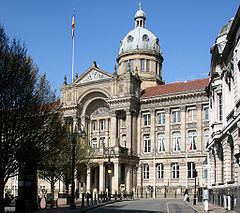Type Municipal headquarters Awards and prizes Grade II* listed | Completed 30 October 1879 Opened 30 October 1879 Construction started 17 June 1874 | |
 | ||
Similar Victoria Square - Birmingham, Hall of Memory - Birmingham, Birmingham Museum and Art G, Birmingham Central Library, Chamberlain Square | ||
Birmingham City Council House in Birmingham, England, is the home of Birmingham City Council, and thus the seat of local government for the city. It provides office accommodation for both employed council officers, including the Chief Executive, and elected council members, plus the council chamber, Lord Mayor's Suite, committee rooms and a large and ornate banqueting suite, complete with minstrel's gallery. The first-floor's exterior balcony is used by visiting dignitaries and victorious sports teams, to address crowds assembled below.
Contents
- Map of Council House Birmingham UK
- Planning
- Construction and extensions
- Memorials
- Use in films
- References
Map of Council House, Birmingham, UK
It is located in Victoria Square in the city centre and is a Grade II* listed building. (Birmingham Town Hall is a separate building, built and used as a concert venue, and is of greater architectural significance, being listed Grade I.) The Council House has its own postcode, B1 1BB.
The side of the building, which faces Chamberlain Square, is the entrance and façade of the Museum and Art Gallery which is partly housed within the same building.
The open space which is now Victoria Square (containing a water feature and steps) was once occupied by Christ Church (built 1805–13, demolished 1899 to be replaced by shops and offices – the Christ Church Buildings, themselves demolished 1970).
Planning
The land on which the Council House and adjacent Museum and Art Gallery are located was purchased in 1853. This land consisted of Ann Street which was home to properties such as the "Cabinet of Curiosities", a clothes shop advertised as "An exhibition for the curious observer of natural phenomena". The building had a clock tower topped with a flagpole. The top was castellated and the walls were whitewashed and adorned in advertisements and messages. The last tenants of the building were the Suffield family, ancestors of J. R. R. Tolkien.
The land was earmarked for development, however constant financial difficulties put all development on hold until 1871 when the council finally agreed to build offices on the site. A design competition was established and the council received 29 entries, which was disappointing in comparison to the 179 entries Sheffield and Birmingham received. However a decision was delayed by further financial difficulties. The council was then split over the Gothic entry by Martin & Chamberlain and the classical entry by Yeoville Thomason.
Construction and extensions
Thomason's design was chosen however amendments to the art gallery entrance and clock tower were made. The clock and tower are known locally as, "Big Brum". Construction commenced on the building in 1874 when the first stone was laid by the then mayor Joseph Chamberlain. The building was completed in 1879 and cost £163,000 (£NaN in 2017).. A debate was held to decide upon the name of the building with the options being The Municipal Hall, Council House or Guildhall.
The Council House was extended almost immediately, 1881–85. The architect was again Yeoville Thomason. This was a combined Art Gallery (and included a museum) and the home of the corporation's Gas Department whose budget subsidised the building as legislation limited the expenditure of ratepayers' taxes on the arts.
Above the main entrance, which faces Victoria Square, is a mosaic by Salviati Burke and Co. of Venice. Above that, the pediment shows Britannia receiving the manufacturers of Birmingham. The carved decoration on the entablature includes green men.
On 9 August 1902, The Council House, along with the Town Hall, was illuminated in celebration of the coronation of King Edward VII.
The Council House was extended a second time 1911-1919 (architects Ashley & Newman) by the building of a new block to the north and connected to it by an intricately designed archway (internally a corridor). The archway or bridge resembles slightly The Bridge of Sighs in Venice.This contains much of the Museum and Art Gallery and, on its ground floor, the Gas Hall, now an exhibition space.
Memorials
Many memorials are housed within the Council House. Most are not available for viewing by the public except upon request. Memorials within the Council House are:
Use in films
The foyer featured in the Cliff Richard film Take Me High, made to appear as a hotel lobby. The glass corridor, banqueting suite and other parts also double as a hotel in Stephen Poliakoff's Dancing on the Edge.
